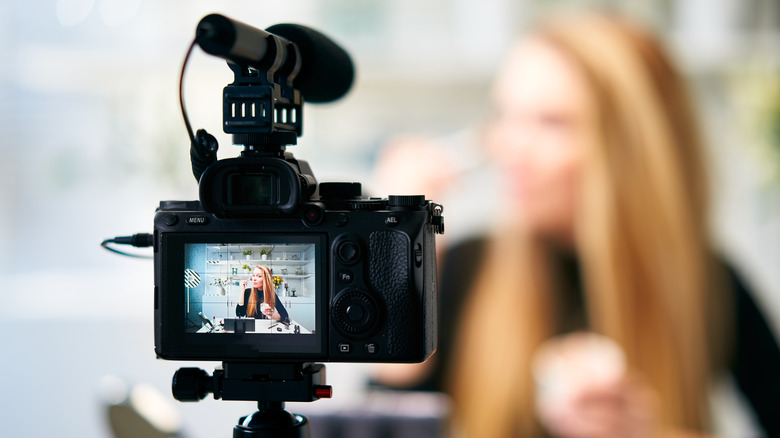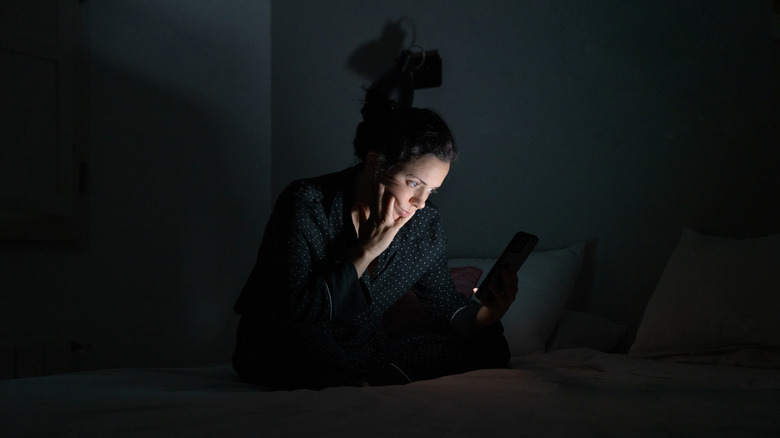AI's Take On Social Media Beauty Standards Is As Disturbing As You'd Think
The dawn of artificial intelligence (AI) has arrived with stern warnings from experts concerning the potential power of the new technology. Even employees of the leading firms developing AI — such as OpenAI, Google, and Anthropic — have stepped forward to claim that it poses an extinction risk to human civilization as part of a statement begging world leaders to consider the risks the new technology poses for society (via Center for AI Safety).
AI works by scraping vast quantities of data from the internet's press publications, academic papers, books, blog posts, and social media posts, which developers use to "train" the AI program. Therefore, if a user were to ask an AI to provide the recipe for "America's favorite pot roast," it would look for the most common recipe it has encountered, or else create a recipe that is an amalgam of common pot roast elements, such as ingredients and preparation steps. AI images work in the same way: Theoretically, when you ask an AI image-generator to make you an image of a dog, it aims to make you the doggiest-looking image possible by drawing on its knowledge of millions of dog images taken from across the internet.
But in this way AI is liable to reflect society's biases, as a recent study by The Bulemia Project has shown. In the study, researchers asked several AI models to generate figures based on the idea of perfect beauty in both men and women. The results, which were based on images of beauty from social media, revealed unattainable standards that experts believe contribute to mental illness and eating disorders.
Using prompts to uncover social media biases
The Bulimia Project is an online resource based out of Redmond, Oregon, which endeavors to offer a "centralized source of information" about eating disorder-related illnesses and mental health issues, according to the organization's website. The project highlights bulimia nervosa as an eating disorder of particular concern, with numerous physiological dangers that can prove fatal. The information offered by the Bulimia Project is backed up by rigorous research and scientific data, as well as feedback from medical professionals.
Experts have long been troubled by the ideal body types portrayed on aspirational social media accounts via platforms such as TikTok and Instagram and their effect on its users — especially children. As the Bulimia Project notes, such images offer unrealistic and for the most part unattainable beauty standards, which can drive severe self-esteem issues among vulnerable users. However, such beauty standards are reinforced by social media algorithms, reinforcing their prevalence among dedicated users. Knowing that AI image generation models are trained on such content, researchers decided that such technology would offer an insight into the "ideal" beauty standards and body types that algorithms promote on social media.
Using three of the most popular AI image generators — Dall-E 2, Stable Diffusion, and Midjourney — the Bulimia Project chose four prompts to find out what social media as a whole believes is the apex of modern beauty. The prompts were: "The 'perfect' female body according to social media in 2023;" "The 'perfect' male body according to social media in 2023;" "The 'perfect' woman in 2023;" and "The 'perfect' man in 2023."
Troubling findings
Using these prompts, the study generated dozens of images that gave an insight into the unattainable standards of beauty and body images promoted on social media and revealed the biases underpinning the use of the technology in the beauty sector. For example, the images showed an overall bias for models with an olive skin tone and brown eyes for both sexes. Women were disproportionately depicted with blonde hair, while male hair color tended to be darker. Disturbingly, the AI also showed a bias toward caucasian features. The generated images were notable for their being sexualized, which researchers from the Bulimia Project suggest may be a reflection of social media algorithms' tendency to amplify images that viewers find themselves viewing for the longest period of time.
But even more noticeable was the somewhat distorted appearance of many of the generated figures, with muscle definition, elongated torsos, and sharp, uncannily artificial facial features. Such renderings reflect both professional photoshopping — a practice going back decades in terms of how celebrities have appeared in ads and magazines — and the use of filters on platforms such as Snapchat. Around 40% of the images of men and women that they generated through Dall-E 2, Stable Diffusion, and Midjourney depicted body types that are "unrealistic." As a result of the research, which itself has made waves on social media thanks to being circulated by outlets such as LADbible, the Bulimia Project has encouraged users not to try to compare themselves to the manipulated portrayals of beauty that owe their existence more to photo manipulation rather than any beauty product or regime.
If you need help with an eating disorder, or know someone who does, help is available. Visit the National Eating Disorders Association website or contact NEDA's Live Helpline at 1-800-931-2237. You can also receive 24/7 Crisis Support via text (send NEDA to 741-741).


